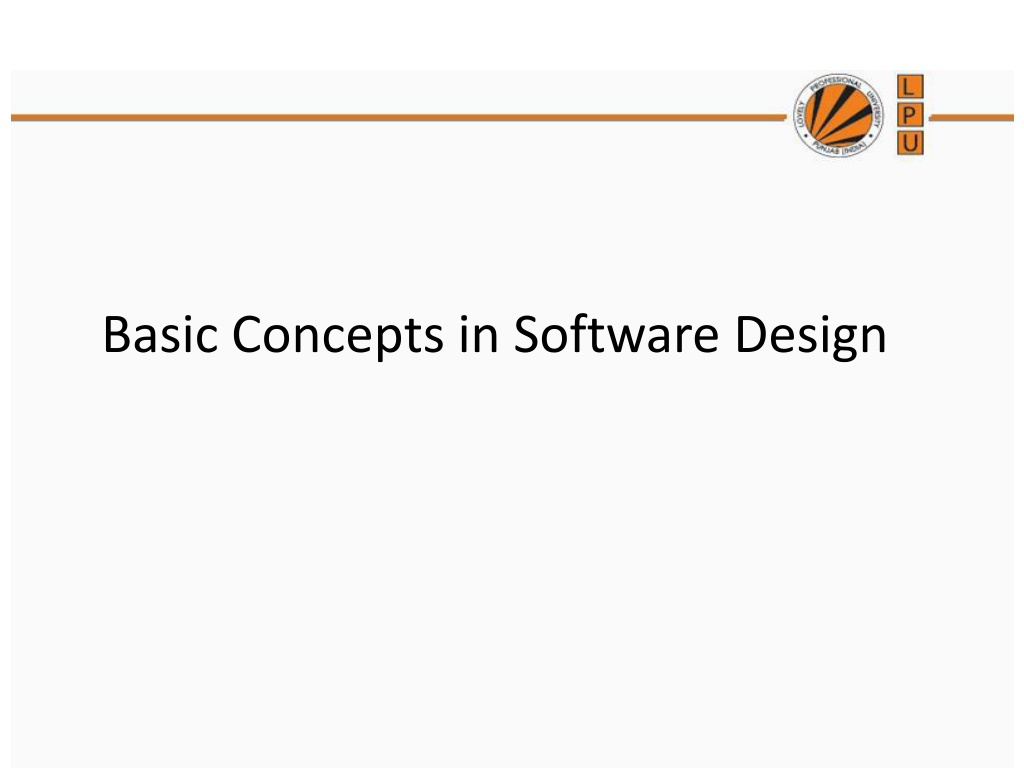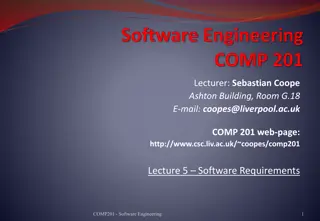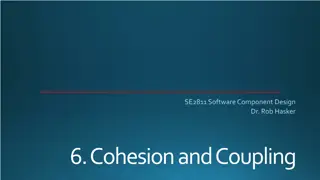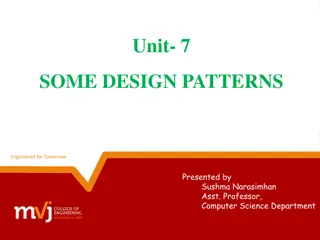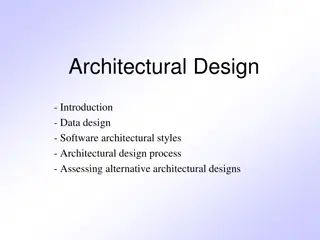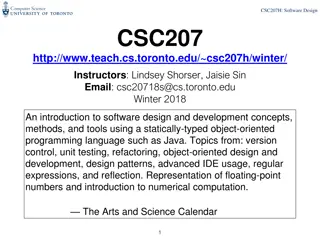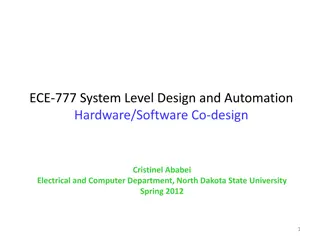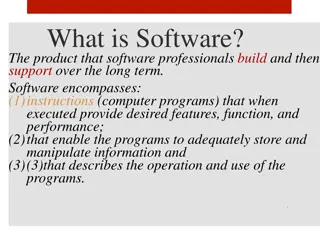Understanding Basic Concepts in Software Design
Software design involves transforming customer requirements into a form suitable for implementation, with activities categorized into preliminary and detailed design stages. High-level design focuses on module identification and control relationships, while detailed design entails defining data structures and algorithms. The difference between analysis and design lies in addressing the problem versus creating a seamless transition to coding. The software design phase results in the development of modules, control relationships, and data structures essential for the design solution.
Download Presentation

Please find below an Image/Link to download the presentation.
The content on the website is provided AS IS for your information and personal use only. It may not be sold, licensed, or shared on other websites without obtaining consent from the author. Download presentation by click this link. If you encounter any issues during the download, it is possible that the publisher has removed the file from their server.
E N D
Presentation Transcript
Basic Concepts in Software Design Software design and its activities Software design deals with transforming the customer requirements, as described in the SRS document, into a form (a set of documents) that is suitable for implementation in a programming language
Basic Concepts in Software Design Design activities can be broadly classified into two important parts: Preliminary (or high-level) design and Detailed design.
Basic Concepts in Software Design High-level design means identification of different modules and the control relationships among them and the definition of the interfaces among these modules. The outcome of high-level design is called the program structure or software architecture. A popular way is to use a tree-like diagram called the structure chart to represent the control hierarchy in a high-level design.
Basic Concepts in Software Design During detailed design, the data structure and the algorithms of the different modules are designed. The outcome of the detailed design stage is usually known as the module-specification document.
Difference between analysis and design The aim of analysis is to understand the problem with a view to eliminate any deficiencies in the requirement specification such as incompleteness, inconsistencies, etc. The model which we are trying to build may be or may not be ready. The aim of design is to produce a model that will provide a seamless transition to the coding phase, i.e. once the requirements are analyzed and found to be satisfactory, a design model is created which can be easily implemented..
Items developed during the software design phase Different modules required to implement the design solution. Control relationship among the identified modules. Data structures of the individual modules.
Characteristics of a good software design Correctness:A good design should correctly implement all the functionalities identified in the SRS document. Understandability:A good design is easily understandable. Efficiency:It should be efficient. Maintainability:It should be easily amenable to change.
Features of a design document It should use consistent and meaningful names for various design components. The design should be modular. The term modularity means that it should use a cleanly decomposed set of modules. It should neatly arrange the modules in a hierarchy, e.g. in a tree-like diagram.
Software Design Issues Cohesion Most researchers and engineers agree that a good software design implies clean decomposition of the problem into modules, and the neat arrangement of these modules in a hierarchy. The primary characteristics of neat module decomposition are high cohesion and low coupling.
Cohesion Cohesion is a measure of functional strength of a module. A module having high cohesion and low coupling is said to be functionally independent of other modules. By the term functional independence, we mean that a cohesive module performs a single task or function. A functionally independent module has minimal interaction with other modules.
Coincidental cohesion A module is said to have coincidental cohesion, if it performs a set of tasks that relate to each other very loosely if at all. In this case, the module contains a random collection of functions. For example, in a transaction processing system (TPS), the get-input, print-error, and summarize- members functions are grouped into one module. The grouping does not have any relevance to the structure of the problem.
Coincidental cohesion A module that only has coincidental cohesion is one supporting tasks that have no meaningful relationship to one another. Page-Jones gives, as an example, a module (not necessarily one that can be implemented using software!) supporting the following tasks.
Logical cohesion: A module is said to be logically cohesive, if all elements of the module perform similar operations. An example of logical cohesion is the case where a set of print functions generating different output reports are arranged into a single module.
Logical cohesion: Again, quoting Page-Jones: ``A logically cohesive module is one whose elements contribute to activities of the same general category in which the activity or activities to be executed are selected from outside the module.' Keeping this definition in mind, consider the following example. Someone contemplating a journey might compile the following list: .
Logical cohesion: Go by Car Go by Train Go by Boat Go by Plane
Temporal Cohesion A temporally cohesive module is one supporting tasks that are all related in time. Ex1: Turn off TV Brush Teeth Ex2:A module whose name is ``Do All Startup Activities,'' or ``Do All Shutdown Activities,'' might only have "temporal cohesion."
Procedural Cohesion A module with (only) procedural cohesion is one supporting different and possibly unrelated activities, in which control passes from one activity to the next. This is a bit better than ``temporal cohesion,'' since we know that there's a fixed ``linear ordering'' of the activities.
Communicational Cohesion A module exhibits communicational cohesion if all the activities it supports use the same input or output data - or access and modify the same part of a data structure. Find Title of Book Find Price of Book Find Publisher of Book Find Author of Book
Sequential Cohesion Again, quoting Page-Jones: ``A sequentially cohesive module is one whose elements are involved in activities such that output data from one activity serves as input data to the next.' Clean Car Body Fill in Holes in Car Sand Car Body Apply Primer
Functional Cohesion A module exhibits ``functional cohesion'' if it supports activities needed for the execution for one and only one problem-related task.
Software Design Software Design Procedural Cohesion Procedural Cohesion occurs in modules whose instructions although accomplish different tasks yet have been combined because there is a specific order in which the tasks are to be completed. Temporal Cohesion Module exhibits temporal cohesion when it contains tasks that are related by the fact that all tasks must be executed in the same time-span. 23
Software Design Software Design Functional Cohesion A and B are part of a single functional task. This is very good reason for them to be contained in the same procedure. Sequential Cohesion Module A outputs some data which forms the input to B. This is the reason for them to be contained in the same procedure. 24
